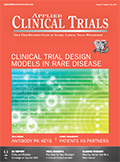Clinical Design: A Deep Dive
Applied Clinical Trials
Findings from a new ACT and SCORR Marketing survey reveal the most actively used flexible design approaches in clinical research-many with application in rare disease.

In this recent peer-reviewed article, http://bit.ly/2kLUu4U, the authors explored master protocols and their increasing use in oncology. “The term master protocol is well accepted to represent an ongoing trial intended for the addition or removal of drugs, arms, and study hypotheses. Master protocols may or may not be adaptive, umbrella, or basket studies. They may be a collection of sub-studies or a complex statistical design or platform for rapid learning and decision-making. Whether umbrella, basket, or platform, a master protocol seeks to update the randomized clinical trial model for the genomic age,” the authors state.
While this article specifically focuses on oncology, asking the question, “what will it take to make the master protocol a standard in oncology research?” master protocols and other innovative or adaptive designs are beneficial for many rare diseases.
With our survey partner, SCORR Marketing, Applied Clinical Trials asked respondents about their use and knowledge of clinical trial design, not specific to oncology or rare diseases. (The survey is available here to download: http://bit.ly/2sH7YCJ). Suffice to say, many respondents who indicated they used master protocols also conducted oncology and/or rare disease research. While master protocols may not be adaptive, adaptive trials, as well as basket trials, ranked first overall in implementation of trial designs.
Adaptive trial design allows for modifications to the clinical development program based on how patients are responding, without undermining the trial’s validity and integrity.
The primary goal is for a more flexible, efficient, and faster study. Adaptive clinical trials have come into their own since the FDA issued

guidance around them in 2006.
Basket trials, on the other hand, have multiple arms (baskets) and can include a single drug evaluated in multiple malignancies or tumor site with the same target; a single drug evaluated as in the previous, but some may have different molecular targets; or multiple baskets representing multiple targeted agents that are evaluated in the same malignancies or tumors.
The basket trial design has limitations, primarily around the complexity of addressing multiple questions in a single protocol.
Regulatory authorities
With the increased use and acceptance of innovative and adaptive trial designs, both the FDA and the European Medicines Agency (EMA) offer scientific advice meetings for sponsors. In our survey, all respondents who said they conducted master protocols also said they solicit regulatory authority advice prior to designing their trials. A full 70% for all trial designs said that they do solicit that advanced scientific advice.
Recently, FDA Commissioner Scott Gottlieb highlighted past and future changes at the agency’s Center for Drug Evaluation and Research (CDER) (http://bit.ly/2J7MoCl). Specifically, he noted “...the FDA has introduced many fundamental advances in how it evaluates drugs for safety and effectiveness, as well as the manner in which clinical trials are guided. These include adaptive approaches to clinical development such as the introduction of seamless trial designs or master protocols or tissue agnostic product approvals.”
Gottlieb continued regarding the specific changes to organizational structures and processes at the FDA, which are intended to “allow our review staff to have more time for reviewing and providing feedback to sponsors on clinical protocols. One goal is to engage sponsors earlier in the development process to ensure that trial designs are efficient and structured in the most effective way to identify risks and measure benefit. Equally important, there will also be more ability to engage external stakeholders, such as disease specialists, academic researchers, and regulatory partners at other agencies. And with patient-focused drug development becoming a reality, ongoing relationships and interactions with patient groups are becoming an important part of our regulatory practices.”
The EMA also offers scientific advice, and for 487 clinical trials hosted between 2009 and 2015, 244 requests for scientific advice were received by July 2017.
In this webcast, http://bit.ly/2kNq966, SGS Life Sciences offers expert insight into scientific advice with regulators, for EMA, FDA, and the individual, national European Union authorities. While experts explained sponsors can ask for advice at anytime during the drug’s development, different points will offer different scenarios. For example, a European biotech with a compound in Phase IIa for women’s health had meetings with both FDA and EMA. The discussion centered on:
• Set-up of the further clinical program
• Assessments to be done in the Phase IIb study
• Further non-clinical testing, in particular carcinogenicity testing
• Development plan for specific sub-indication
The company left with a clear outcome for its Phase IIb study, as well as improving assessments to its Phase III study. Other discussion points that SGS advised early in development included study design, development program, CMC aspects, and pediatric development.

Study innovation
In addition to designs, we asked respondents about the trial innovations they are using or plan to use. The majority responded that they are using EHR data (63%), followed by siteless studies (31%), blockchain (17%), and semantic technology (14%).
At a recent conference, CEO of Sarah Cannon Research Institute, Dee Anna Smith, presented the components of its cancer data warehouse. Those included its “systems” such as Epic; bone marrow transplant solution; radiation oncology EHR; cancer registry; and cancer navigation system. Data from the molecular profiling labs and affiliated medical oncologists EMR were also included in the warehouse.
Sarah Cannon is part of the larger HCA health network, and using the data from the warehouse, Smith said the company was able to identify 17,383 patients with breast, colon, gastrointestinal, and lung cancer. Of those, 6,092 were newly diagnosed and were navigated through Cannon and retained as patients. Keeping patients within the HCA system helps them access to the clinical trials through Sarah Cannon, and not be referred out of the system for care.
Siteless studies, also called remote, decentralized or virtual trials, have been an increasing choice for clinical operations in looking for more patient-centric choices. Siteless trials use digital technology to allow some or all aspects of a clinical trial to be carried out at a participant’s home or local physician’s office, rather than at a central trial site such as a large hospital.
In early March, Novartis announced that its alliance with Science 37 would initiate up to 10 new clinical trials over the next three years. The studies will blend virtual and traditional models, with increasing degrees of decentralization toward a mostly siteless model. Novartis was an early investor in Science 37, a decentralized clinical trial technology and design provider that uses its proprietary Network Oriented Research Assistant (NORA®) technology), which enables patients to participate in studies using mobile devices and telemedicine services. To date, Novartis and Science 37 have initiated virtual trials for cluster headache, acne, and nonalcoholic steatohepatitis (NASH). The decentralized trials are expected to begin later this year in the US in the areas of dermatology, neuroscience, and oncology. In May, UCB also announced the use of NORA in its trials.
Our survey did tackle a number of other questions, including gains or benefits expected by using innovation or different trial designs. All received about a 70% score in the following: better quality data; better recruitment/retention; cost savings; faster executive and regulatory compliance.
Respondents also noted that adaptive trials and studies that use EHR data provide the highest return on investment.
Lisa Henderson is Editor-in-Chief of Applied Clinical Trials. She can be reached at lisa.henderson@ubm.com. Follow Lisa on Twitter: @trialsonline

Improving Relationships and Diversifying the Site Selection Process
April 17th 2025In this episode of the Applied Clinical Trials Podcast, Liz Beatty, co-founder and chief strategy officer, Inato, discusses a number of topics around site engagement including community-based sites, the role of technology in improving site/sponsor relationships, how increased operational costs are impacting the industry, and more.
Behind the Buzz: Why Clinical Research Leaders Flock to SCOPE Summit
February 7th 2025In this episode, we meet with Micah Lieberman, Executive Conference Director for SCOPE Summit (Summit for Clinical Ops Executives) at Cambridge Innovation Institute. We will dive deep into the critical role of collaboration within the clinical research ecosystem. How do we bring together diverse stakeholders—sponsors, CROs, clinical trial tech innovators, suppliers, patients, sites, advocacy organizations, investors, and non-profits—to share best practices in trial design, program planning, innovation, and clinical operations? We’ll explore why it’s vital for thought leaders to step beyond their own organizations and learn from others, exchanging ideas that drive advancements in clinical research. Additionally, we’ll discuss the pivotal role of scientific conferences like SCOPE Summit in fostering these essential connections and collaborations, helping shape the future of clinical trials. Join us as we uncover how collective wisdom and cross-industry partnerships are transforming the landscape of clinical research.